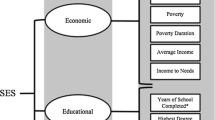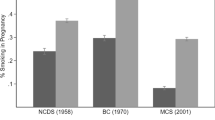Abstract
Background
Many studies link childhood socioeconomic status (SES) to body mass index (BMI), but few account for the impact of socioeconomic mobility throughout the lifespan.
Purpose
This study aims to investigate the impact of socioeconomic mobility on changes in BMI in childhood. Analyses tested whether [1] socioeconomic status influences BMI, [2] changes in socioeconomic status impact changes in BMI, and [3] timing of socioeconomic status mobility impacts BMI.
Methods
Secondary data spanning birth to age 9 were analyzed. SES and BMI were investigated with gender, birth weight, maternal race/ethnicity, and maternal nativity as covariates. Autoregressive structural equation modeling and latent growth modeling were used.
Results
Socioeconomic status in the first year of life predicted body mass index. Child covariates were consistently associated with body mass index. Rate of change in socioeconomic status did not predict change in body mass index.
Conclusions
The findings suggest that early socioeconomic status may most influence body mass in later childhood.


Similar content being viewed by others
References
Phelan JC, Link BG, Tehranifar P. Social conditions as fundamental causes of health inequalities: Theory, evidence, and policy implications. Journal of Health and Social Behavior. 2010; 51(S): S28-S40.
Luo YL, Waite LJ. The impact of childhood and adult SES on physical, mental, and cognitive well-being in later life. J Gerontol B Psychol Sci Soc Sci. 2005; 60(2): S93-S101.
Cohen S, Janicki-Deverts D, Chen E, Matthews K. Childhood socioeconomic status and adult health. Annals of the New York Academy of Sciences. 2010; 1186: 37-55.
Hertzman C, Weins M. Child development and long-term outcomes: a population health perspective and summary of successful interventions. Social Science Medicine. 1996; 43(7): 1083-1095.
Power C, Hertzman C. Social and biological pathways linking early life and adult disease. British Medical Bulletin. 1997; 53(1): 210-221.
Pollitt R, Rose K, Kaufman S. Evaluating the evidence for models of life course socioeconomic factors and cardiovascular outcomes: a systematic review. BMC Public Health. 2005; 5(7): 1-13.
Kalil RE. Synapse formation in the developing brain. Scientific American. 1989; 261(6): 76.
Pollitt RA, Kaufman JS, Rose KM, Diez-Roux AV, Zeng D, Heiss G. Early-life and adult socioeconomic status and inflammatory risk markers in adulthood. Eur J Epidemiol. 2007; 22(1): 55-66.
Galobardes B, Smith G, Lynch J. Systematic review of the influence of childhood socioeconomic circumstances on risk for cardiovascular disease in adulthood. Annals of Epidemiology. 2006; 16(2): 91-104.
Power C, Manor O, Matthews S. The duration and timing of exposure: Effects of socioeconomic environment on adult health. American Journal of Public Health. 1999; 89(7): 1059-1065.
Evans G, Kim P. Childhood poverty and health: cumulative risk exposure and stress dysregulation. Psychological Science. 2007; 18(11): 953-957.
Dudina A, Cooney MT, Bacquer D, et al. Relationships between body mass index, cardiovascular mortality, and risk factors: a report from the SCORE investigators. European Journal of Cardiovascular Preventive Rehabilitation. 2011; 18(5): 731-742.
Reichman N, Teitler J, Garfinkle L, McLanahan S. 2001 “Fragile Families”: sample and design. Children Youth and Services Review. 303–326
Cole T, Faith M, Pietroelli A, Heo M. What is the best measure of adiposity change in growing children: BMI, BMI%, BMI z-score or BMI centile? European Journal of Clinical Nutrition. 2005; 59(3): 419-425.
Godley J, McLaren L. Socioeconomic status and body mass index in Canada: Exploring measures and mechanisms of SES and BMI in Canada. Canadian Review of Sociology. 2010; 47(4): 381-403.
Danner F, Toland M. The interactive role of socioeconomic status, race/ethnicity, and birth weight on trajectories of body mass index growth in children and adolescents. Journal of Early Adolescence. 2013; 33(3): 293-314.
Sanchez-Vaznaugh E, Kawachi I, Subramanian S, Sanchez B, Acevedo-Garcia D. Do socioeconomic gradients in body mass index vary by race/ethnicity, gender, and birthplace? American Journal of Epidemiology. 2009; 169(9): 1102-1112.
Muthen B, Muthen LK. Mplus (version 7.11) [computer software]. Muthen & Muthen: Los Angeles; 2013.
Kline RB. Principles and Practice of Structural Equation Modeling. 3rd ed. New York, NY: Guilford Press; 2010.
Raykov T, Tomer A, Nesselroade JR. Reporting structural equation modeling results in Psychology and Aging: Some proposed guidelines. Psychology and Aging. 1991; 6(4): 499-503.
Hu L, Bentler PM. Cutoff criteria for fit indexes in covariance structure analysis: Conventional criteria versus new alternatives. Structural Equation Modeling. 1999; 6(1): 1-55.
Aitsi-Selmi A, Batty G, et al. Childhood socioeconomic position, adult socioeconomic position and social mobility in relation to markers of adiposity in early adulthood: evidence of differential effects by gender in the 1978/79 Ribeirao Preto cohort study. International Journal of Obesity. 2013; 7(3): 439-447.
Parsons TJ, Power C, Logan S, Summerbell CD. Childhood predictors of adult obesity: a systematic review. International Journal of Obesity and Related Metabolic Disorders. 1999; 23(8): S1-S107.
Revenson TA, Pranikoff JR. A contextual approach to treatment decision making in long-term breast cancer survivorship. Health Psychology. 2005; 25(4): 593-598.
Adler NE, Rehkopf DH. U.S. disparities in health: Descriptions, causes, mechanisms. Annual Review of Public Health. 2008; 29: 235-252.
Acknowledgments
The authors wish to thank Dr. Angela Crossman and Dr. Joel Erblich for their comments on an earlier draft of this manuscript.
Authors’ Statement of Conflict of Interest and Adherence to Ethical Standards
Authors Starkey and Revenson declare that they have no conflict of interest. All procedures, including the informed consent process, were conducted in accordance with the ethical standards of the responsible committee on human experimentation (institutional and national) and with the Helsinki Declaration of 1975, as revised in 2000.
Author information
Authors and Affiliations
Corresponding author
About this article
Cite this article
Starkey, L., Revenson, T.A. Early Changes in Socioeconomic Status Do Not Predict Changes in Body Mass in the First Decade of Life. ann. behav. med. 49, 212–220 (2015). https://doi.org/10.1007/s12160-014-9648-1
Published:
Issue Date:
DOI: https://doi.org/10.1007/s12160-014-9648-1




